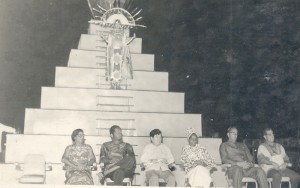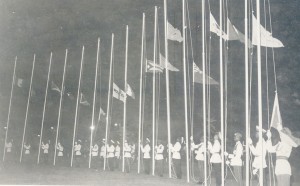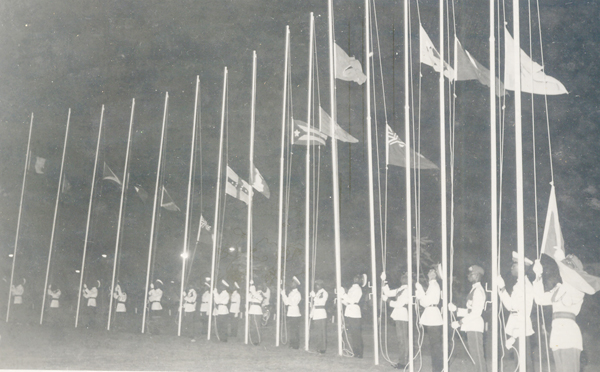CARIFESTA through the years, a brief glimpse of Burnham’s cultural legacy
By Lloyd F Kandasammy
On 24 February 1970 a convention of Caribbean Writers and Artists at the Critchlow Labour College was hosted in Guyana under the chairmanship of the renowned national poet, the honourable Martin Carter, then Minister of Information and Culture. During this convention the participants lamented about the absence of an appropriate vehicle to showcase the rich cultural heritage of the Region and at the same time give recognition to its outstanding artists and art forms.
The previous attempts at staging a regional cultural festival in 1958 in Trinidad and that of 1967 in London were not totally successful in attracting full participation from all countries. In the circumstance, the idea of staging a local festival was suggested by the participants to showcase the Caribbean’s artists. This was readily endorsed by then Prime Minister of Guyana, Hon. Linden Forbes Sampson Burnham who then bestowed the task of planning this activity on the National History and Arts Council.
In September 1970 the Secretariat was established and in May 1971 Lynette Dolphin was appointed as director and Frank Pilgrim was selected as commissioner. This duo was also assisted by numerous members of the council including A.J. Seymour, Basil Hinds, Rajkumari Singh, Ken Corsbie and others. They were joined in April 1972 by Bunny Fernandes as the Secretariat’s co op business manager.
In their annual report for the proceedings of the Council for 1970 the secretariat noted that the name of the festival CARIFESTA: Caribbean Festival of Creative Arts was selected. Additionally they announced a competition for the design of a logo for which the prize of $500 was offered. Schools, auditoriums and other buildings were inspected and estimates were quickly prepared to determine their suitability for performances by the wide spectrum of artists which the festival was going to attract.
1972 became widely known as CARIFESTA year.
The country was bustling with activity as the anticipation of the region’s first true cultural exposition was about to commence. On 25 August 1972 Guyana was finally on show as thousands gathered at the various venues to celebrate the grandest cultural spectacle this country has ever hosted. The programme over this period took the form of plays, monologues, poetry, dancing, folklore, steel band music and calypsos, lectures, concerts, pop shows, pageants, discussions, sculpture, art and international exhibitions, child art exhibitions, demonstrations of carving, ceramics, painting and singing.
For twenty two days nations and people, put aside differences and unity was enhanced with a cultural exposition, a riot of colour and celebration by all, made richer by the sparkling traditions of the peoples of the region each distinct yet bonded together by a common identity, that of creativity.
‘CARIFESTA described the people of the sun in all of their glory represents the joining and communion of all the areas and styles of individual artistic expressions that come out of the cultural diversity that is the Caribbean.’
These words by the Honourable Prime Minister of Jamaica Michael Manley encapsulate the essence of CARIFESTA which was staged with great fanfare throughout the Caribbean; Jamaica 1976, Cuba 1979, Barbados 1981, Trinidad and Tobago 1992, 1995 and 2006, St. Kitts and Nevis 1995 and Suriname 2003.
The cultural and artistic success of CARIFESTA 1972 led to a call to institutionalize the festival within the emerging structure of the Caribbean Community. In the circumstances the Heads of Government, at the 1972 Heads of Government Meeting unanimously approved the establishment of a permanent unit within the Secretariat with oversight functions for coordinating subsequent CARIFESTA events.
Four years later Jamaica hosted the region’s second CARIFESTA, under the theme ‘A Hallmark of Cultural Extravaganza.’ This festival was organized in Jamaica around Caribbean heroes: this time, Toussaint L’Ouverture, Jose Martí, Juarez, Bolivar and Marcus Garvey.
For twelve days Kingston and other parts of Jamaica were transformed into a sphere of riot and colour as musicians, dancers, steel bands, artists and sculptors all showcased their respective identities and distinctive cultural traditions. For its part Guyana’s contingent consisted of forty five of the nation’s finest artistes noted examples included the esteemed pianist Ray Luck, the Yoruba Singers, the Triveni group folk dancers from Linden and others.
Three years later in 1979 despite some criticism the theatres, stadiums, plazas and streets of Havana, Cuba were the setting for cultural presentations by the numerous countries in the region as nations gathered to celebrate CARIFESTA III: A Rainbow of Peoples Under One Caribbean Sun. As was the case with previous festivals the Guyana contingent did not fail to impress. The Chronicle symphony Orchestra, despite having to borrow pan stands to perform outshone the bands from the other nations. ‘Pans aglitter they held the audiences spell bound for 15 minutes. Then the entire theatre stood and literally clapped their hands for a full minute.’ The Yoruba Singers, the National Dance Company and other representatives also gained rave reviews in the local press.
After extensive performances in dance, music and drama together with several workshops to address the creative and performing arts CARIFESTA III closed with a grand Caribbean Carnival along Havana’s malecon. Leading the parade of nations was the Guyana contingent. The ‘crush of humanity was dwarfed by the towering rainbow illuminated floats with their dancers on top of them, confetti was thrown about to add to the carnival atmosphere’ as the curtains closed on another successful CARIFESTA.
For 16 days Barbados was transformed by a torrent of cultural expression as that country hosted CARIFESTA IV; Living Images of the Sun. The national stadium was filled to capacity as Prime Minister Tom Adams declared the festival open as volleys of balloons rose in the sky and masquerade dancers from Guyana and other dancers from Guadeloupe and Trinidad and Tobago staged impromptu dances to the sounds of Sparrow’s music. Throughout the course of this festival, reviews in the press noted the advances made by the National Dance Company of Guyana from their first performance in 1972. The Yoruba Singers also proved to be another crowd favourite.
All over Barbados, crowds cheered and danced as the regions finest talent was put on display. As was the case with Cuba, the festival climaxed with a grand street carnival; ‘spangles and sequins caught the sunlight and threw it back in shimmering shards that dazzled the eyes of Barbadians and visitors who lined the route of the parade.
For a number of reasons CARIFESTA was not staged until 1992 in Trinidad. This eleven year lull in the festival’s hosting is linked to a number of factors inclusive of the financial and administrative resources required. Jamaica did indicate their willingness to be the venue again in 1989 but regrettably these plans were disrupted by the devastation of Hurricane Gilbert.
It was not until 1992 that the festival was rejuvenated when Trinidad and Tobago hosted CARIFESTA V: Together in Strength. Despite criticisms the festival was successful and Trinidad again hosted CARIFESTA VI: The World’s Best Cultural Mix in 1995. The reports in the press heralded the return of the region’s festival which opened with swirling dancers and high kicking dancers.
With the staccato beat of drums and the swirl of long colourful dresses the Caribbean community opened its premier arts festival in Trinidad. The opening ceremony was a cultural extravaganza with thousands of performers as the stadium flamed into colour and a frenzy of action with a carnival style pageant. Visitors were treated to a magnificent spectacle as hundreds of school children formed the sun, the map of Trinidad and Tobago and the CARIFESTA logo followed by a parade of the participating nations.
During the course of the festival tassa drummers, African drummer, choirs, musicians, dancers, actors, sculptors and others gave exuberant performances, despite a hectic schedule which limited performers from viewing other groups, to enthusiastic audiences. Guyana’s premier dance troupe The National Dance Company as they had done in previous festivals did not fail to disappoint, equally outstanding were Mumtaz Ali and troupe. Three years later Trinidad and Tobago again hosted CARIFESTA VI: The World’s Best Cultural Mix with similar fanfare. Emphasis was however placed on youth.
In 2000 CARIFESTA VII: Caribbean Arts and Culture, Reflecting, Consolidating, Moving on’ was hosted in St. Kitts & Nevis the first and only OECS state to stage the festival. Despite some hiccups with limitations of the sizes of the participating countries contingents the festival was staged with great enthusiasm by all attending. For their part Guyana presented GUYFESTA 2000 a two hour production directed by Francis Farrier. It reflected the rainbow of national cultures, ethnic plurality, different kinds of indigenous performances and traditions.
In 2003 CARIFESTAVIII: Many Cultures: The Essence of Togetherness, The Spirit of the Caribbean was hosted by Suriname. In many ways it represented a sort of homecoming to the South American shores where the festival originated. Brightly coloured costumes, a wide range of tropical rhythms, many tongues, dances and beats of all varieties filled Paramaribo and neighbouring areas as the Caribbean’s distinctive culture was again put on display.
Independence square in Paramaribo came alive as the week long celebrations kicked off with a grand parade of close to 1000 representatives from different countries. Of significance was the emphasis on the Indigenous peoples. For this purpose a special village was erected. The diversity of cultures displayed included an Indonesian puppet show, a postal exhibition at the gardens of Independence Square, drumming and other art forms.

Three years later CARIFESTA IX: Celebrating Our People, Contesting the World Stage was again hosted by Trinidad and Tobago in 2006. The spectacle staged by Trinidad was considerably larger than their previous attempts. The opening ceremony was unrivalled in colour and rhythm as hundreds of dancers swarmed across the field depicting the rich indigenous heritage followed by ‘Reverence’ leading to the portrayal of other peoples.
The diversity of the region’s culture was further emphasised with a Parade of Nations, where nations showcased their national costumes and flags. Masqueraders added an extra touch of excitement followed by a contingent of African drummers as all frolicked to the sweet sounds of reggae, calypso and soca music. The next few days were characterised with numerous events as nations strutted their stuff with great enthusiasm.
In 2008 CARIFESTA returns to Guyana, a symbolic homecoming for the regions 10th festival. The news of Guyana once again staging CARIFESTA was warmly greeted and endorsed by the populace, many of whom have recounted with vivid memories the extravaganza of the first festival in 1972.
In August 2008, a cultural spectacle will be staged with great fanfare as the potpourri of traditions, from music to the culinary arts, painting, music, drama, fashion and poetry, literature and sculptures, just to name a few will transform Georgetown, New Amsterdam and other parts of the country into one grand theatre. Its effect will no doubt reawaken the creative vibes within the region and most importantly stimulate the country’s youth, inspiring the present and future generations under ‘One Caribbean, One Purpose; Our Culture Enriched,’ to embrace their unique and distinctive cultural heritage.

As the time draws closer for the return of Carifesta to the shores of Guyana the undermining of the founder of this great regional cultural movement cannot be denied. Recently there has been a tendency to sideline President Burnham despite the calls to have him recognised for his achievements. Despite what ever hidden agendas there may be the cultural legacy of this festival owes its existence to Burnham, were it not for his vision it would never have occurred.
Opening Ceremony National Park


